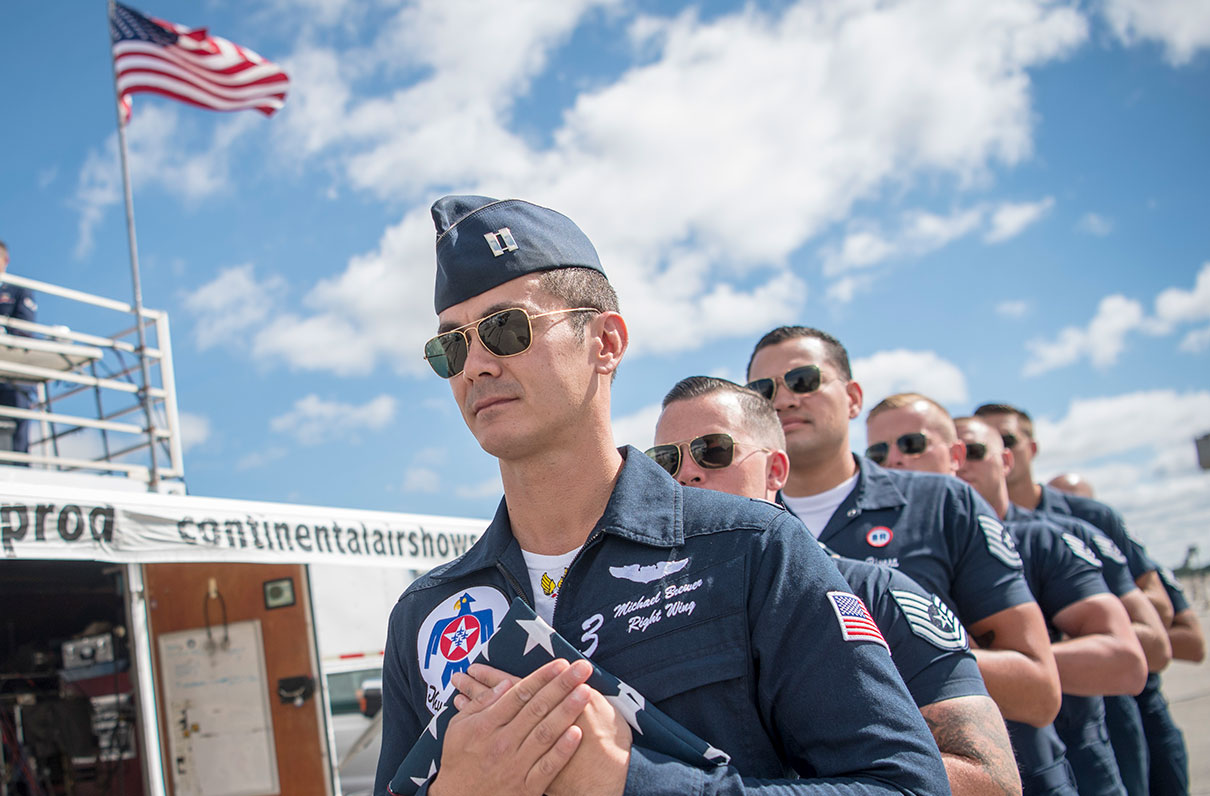Editor's note: This article by Michael Fabey first appeared in the October issue of Military Officer magazine. Learn more about the magazine here; learn more about joining MOAA here.)
Peter Dombrowski is the director of the Cyber and Innovation Policy Institute and a professor of strategy in the Strategic and Operational Research Department at the U.S. Naval War College. He is the author of numerous articles, publications, and books, including The End of Grand Strategy: U.S. Maritime Operations in the 21st Century (Cornell University Press, 2018), with coauthor Simon Reich, professor of political science and a member of the Division of Global Affairs faculty at Rutgers University–Newark. The book explores why the American grand strategy is dead and examines major maritime operations to show the numerous reactive strategies the U.S. now uses because of global and political changes.
In an interview with Military Officer, Dombrowski deciphers the administration’s attempts to implement a strategic geopolitical vision, the impact of greater competition in the Arctic, the importance of continued military exercises, the current and future roles of aircraft carriers, and the rise of China.
Q. Does this administration have a grand strategy? Is it one of naval primacy?
A. The question is: Will [President Donald] Trump have a grand strategy? There’s a difference between when the president takes a position in public with his tweets and what happens in the military bureaucracy and the national security bureaucracy. The underlying arguments about [the] nature of the threat, [the] natureof conflict, [and] the actors involved still holds.
There are two answers. What we’ve seen is there’s been more bluster than actual action, in North Korea [and] in Iran, to date. The action hasn’t been in using a military instrument. The hope is it stays that way.
The second answer is it’s still too early to say. I don’t think we can expect major changes in the nature of a grand strategy quickly. There are lots of bureaucratic and human impediments, even within Trump’s own cabinet, with [Secretary of State Michael] Pompeo and [National Security Advisor John] Bolton. There is a tremendous difference about how to handle the biggest strategic questions of the day.
Q. The U.S. still is operating under a national defense strategy formulated and implemented by former Defense Secretary Jim Mattis. What was the impact of that strategy? Has that changed any since his departure and, if so, how?
A. The Mattis national defense strategy (NDS), [National Security Council] national security strategy (NSS), and subsequent documents that have been issued — that was a pretty substantial change from the Obama and George W. Bush era because it sorted out some of the confusion of the post-Cold War era. We’re going to focus on great power competition. That great power is, first and foremost, China and, second, Russia.
If you take the strategic approach seriously, the resources should flow to those two competitors more so than other things.
But, in the last few months, there’s been a return to “sandbox” — the Mattis sandbox. We are once again preoccupied with events in the Persian Gulf — not just Syria, but also Iran, trying to keep the Gulf open.
It’s the anti-great-power approach. In documents, the shadow of Mattis remains. Butin implementation, it’s been left to folks who were not Mattis’ people, who have different views. They are not implementing the strategy as written.
Q. How do the NDS and NSS figure into an overall grand strategy, especially in dealing with the peer competitors?
A. The grand strategy is not just a maritime, military strategy. It’s a much more broad set of policies. Both the NDS and NSS, under Trump, are only instruments. There appeared to be a plus in resources and attention in terms of manpower, analysis, and diplomacy.
Actually, it’s been a military action. There is no foreign aid component to speak of. There is no increase in urgency. Agencies are operating with less-than-full complements of political appointees. What this means is, with the NDS, even under Trump, the implementation is hampered by the fact [the administration is] not concentrating on making those instruments of national power workable. You see a lot of diplomatic stuff going on, [which is] not on par with the much larger government bureaucracy.
Q. The Arctic increasingly has become a new major battleground for great power competition, with the U.S. Coast Guard representing the greatest American force of presence in the region. How do you see this playing into grand strategy planning?
A. It’s a good-news-bad-news story. Whatever the administration says about climate change, the fact is, the pace of change and the opening
of ice is increasing rapidly. Under the newest projections, for longer stretches of the year, it won’t be ice-free, but it will be passable. With double-hulled vessels, at least a couple of months a year, there will be big changes in global trade patterns.
The good news for the Coast Guard is there is finally appropriations money to buy icebreakers. It’s a big step.
[RELATED: Cutting a Lonely Path: The Coast Guard's Heavy Icebreaker in the Arctic]
The bad news is the topline Coast Guard budget has not increased — it’s decreased. After a howl from Congress and constituents, it’s been plussed-up some. But there are only so many national security cutters and buoy tenders, and there’s a demand signal in the South China Sea for FONOPs (Freedom of Navigation Operations) for maritime security. The ability of the Coast Guard to fulfill the demand signal is limited, even with icebreakers coming on.
And it’s essential for global commerce and [the U.S.] trade policy.
Q. If the U.S. Coast Guard is not to serve the role of naval primacy, what role should it have?
A. That’s what makes the Coast Guard valuable for planners. If war breaks out, they’re a military service. In peacetime, they have a role that’s much broader, including commerce. They’re a jack-of-all-trades, a Swiss army knife. That makes them very much in demand, not just globally but domestically.
Q. In your book, you discuss the importance of exercises for the U.S. military and the forces of its allies and partners. Why are such operations vital for joint and solo operations?
A. I’m a straight civilian. If I’ve learned anything in my time working for the military, it’s the importance of exercising. It’s a way to ensure readiness, a way to improve capabilities [and] to make sure everybody is trained appropriately, [and] a way to make sure all systems [operate as they should] in very complex pieces of equipment.
Exercises are integral to what militaries do. We want them to be available in case of war — exercising is part of what they do. In a strategic sense, they play a ... number of roles, including reassurance of allies. We will be better. We will be able to operate with one another. Interoperability isn’t just equipment, it’s also procurement and policies, [communications], and protocols.
They also have a determent function — almost assuredly against the Chinese. There’s the Malabar exercise [near India]; the Chinese watch that very closely. One of the things it represents is that the U.S. and India are more closely aligned.
Q. How can military exercises play a strategic role?
A. Exercises take place regardless. With a sound strategy supported across the government, the exercise becomes a tool of the overarching strategic vision.
For NATO, it’s part of alliance management. We have spent a lot of time working on exercising activities in Europe. It’s how we communicate with allies, how we demonstrate our priorities and make sure they’re on board.
Q. The administration has cited costs in curtailing recent exercises off the Korean Peninsula. Should that be a factor in determining whether to exercise with allied or partner nations?
A. Regarding costs, the president has talked about the cost of our Korean exercises. What are the real costs? The exercises, whether it’s unilateral with just us, or bilateral with the Koreans, or multilateral — with the military, you want them to be effective. You want to do the exercise. What you do in peacetime is a preparatory action. It’s marginally expensive with other countries, but the benefits outweigh the marginal costs. The expenses do not increase exponentially if you are doing the exercise with allies or partners. The cost question can be overstated. [Operating] the military is expensive to begin with.
... If you polled generals and admirals on military relations and alliance relations, they would say potential military and political benefits outweigh the budgetary impact of exercises. ... If you want to save money, I don’t think an exercise is the first place to look.
Q. After the end of World War II, throughout the Cold War, and even into recent operations against terrorism, aircraft carriers have been considered to be vital strategic platforms. But, recently, the benefits of such ships have been called into question. Are they too costly?
A. This is a real hot-button [issue].
For the topline, whatever strategy they are pursuing — even the isolationists — they’re going to have some number of carrier strike groups. Carriers are a very good thing for U.S. national power. Even if we decided to withdraw our commitments globally and have only hemispheric defense, we would still need to have aircraft carriers as part of that force. The number is the question. Some question its utility in high-end conflict versus China and Russia, the great powers.
If we want to operate close to the Chinese littorals in wartime, carriers probably cannot and should not do that. There is a role for them but not operating up and close to that bad guy — and all of that land-based aircraft and missile vulnerability. The cost of protecting the carrier then is prohibitive.
Except off the coast of mainland China and certain parts of the Russian littoral, carriers still will be able to operate almost everywhere else in the world.
A smaller number is probably possible, but that is a very political issue, with [congressional input].
Q. What about using a carrier strike group to conduct freedom-of-navigation patrols in a place like the South China Sea?
A. It’s a legitimate question. It’s a very, very, very expensive system to use for presence purposes.
There are other ways to assert American presence, without using a billion-dollar carrier with air wings, not to mention escorts. If you’re talking about presence, there are much cheaper and more effective ways to do presence. That’s where budgetary [concerns] come into play. If that’s the primary purpose, try something else with more bang for the buck without the carrier. Carriers have many different roles.
Q. What about the carrier’s role in the future?
A. The nature of warfare is changing substantially. The nature is not just the hull but what’s aboard the carrier. The F-35 [Lightning II Joint Strike Fighter] is very different from previous [aircraft] iterations. Further off, unmanned systems will be different from F-35s.
Do you need a ship the size of a nuclear carrier to carry drones and unmanned systems to the fight? We’re in that period of change. It’s a tremendous evolution. I don’t think anybody knows what the fight is going to look like in 2039-40.
Q. China is developing its own fleet of carriers. Should the U.S. send carrier strike groups through the Taiwan Strait to assert its right to operate there?
A. There’s a whole lot of nuance. When are we going to do this?
In peacetime, everything is going well, diplomatically. The American Navy and any other navy has the right to pass through the strait. But once we get into a crisis, even a diplomatic crisis, the symbolism of a carrier takes far greater weight. The risk is much greater. The carrier is a very valuable system and can defend itself, but it is extremely vulnerable close in.
Even [retired] Adm. [Harry] Harris [former Pacific Command commander and now ambassador to South Korea] would not be advocating putting a carrier in the strait during a crisis. You’ve got to think: If deterrence fails, we go to war. If war breaks out and we lose a carrier, if we have 10 of them, we’re losing a tenth of that naval power. Even if it’s just a mission-kill — bang, off the bat, the battle of the first salvo. If you put a carrier at risk for presence in a diplomatic crisis, that is a very big risk.
Q. There are those who believe the Chinese military component is becoming increasingly stronger in the nation’s geopolitical rise to power. What are your thoughts?
A. They have three carriers in progress. You can chart China’s naval modernization. It’s quite startling. If you look at the growth of the Germany navy prior to World War II, you would see some parallels in the pace and change and size and number of ships and capabilities. And there’s the professionalism of the Chinese navy.
It’s impressive to watch and a great challenge for the U.S. Navy.
Michael Fabey is a freelance writer based in Virginia. He is the author of Crashback (Scribner, 2017). His last feature for Military Officer was “Rising Threat,” December 2018, which can be accessed by members through MOAA's Military Officer digital archive page.


